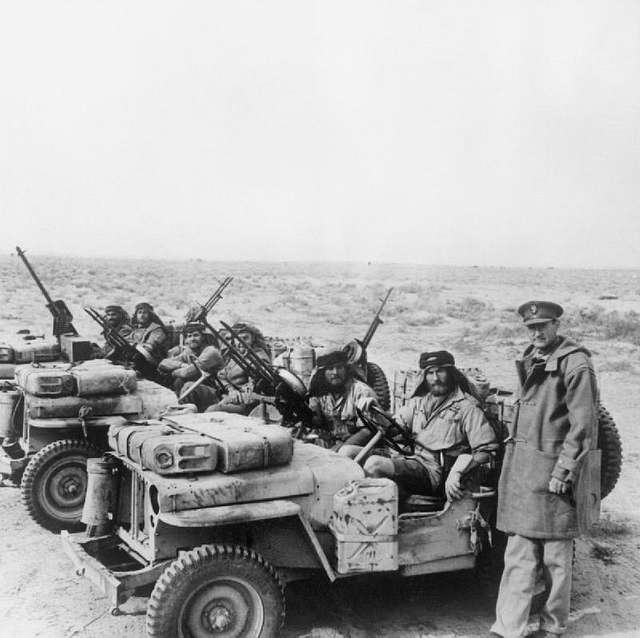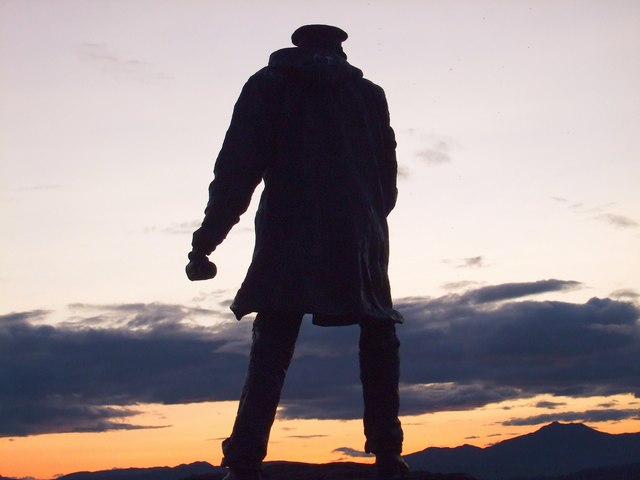[imagesource: Wikimedia Commons]
The only place that mad truly thrives is in war.
Lieutenant-Colonel David Stirling, a legend from the Second World War and founder of the Special Air Service (SAS), is a case in point.
He often became bored and then made up extreme wartime adventures for himself – ones that often ended badly, not that it ever thwarted Stirling who merely shrugged it off and carried on.
Once, while bored in Cairo during WWII, he jumped out of a plane sans proper training or a helmet, ripped his parachute on the way down, and hit the ground so hard that he was temporarily blinded and paralysed.
Then, while still on crutches from that accident, he snuck into the British Middle East HQ to ultimately put a proposal directly into the hands of the generals – the proposal that ultimately founded the SAS.
“I had to use my crutches as a kind of ladder to get over the wire when the guards weren’t looking,” Stirling recalled of that one-man mission.
He went on to become the commander of the original SAS, carrying out sabotage missions and destroying scores of enemy aircraft, fuel tankers, trucks, communications, and anything else to support larger operations in North Africa and disrupt enemy supply lines.
As The Telegraph notes “the legend of Stirling’s SAS is the stuff of swashbuckling adventure”:
…daring, not-for-the-faint-hearted raids achieved with swagger, bravado, and straight-up blagging their way through enemy checkpoints. British tabloids would give Stirling the nickname “the Phantom Major”.
Captured in January 1943, Stirling spent the remainder of the war escaping POW camps and was finally sent to Colditz. His story, and the formation of the SAS, is told in the BBC’s new series, SAS Rogue Heroes, from Peaky Blinders creator Stephen Knight.
Ben Macintyre described Stirling as “one of those people who thrive in war, having failed at peace” in the book that inspired the series.
According to the assessment of Field Marshal Bernard Montgomery, Stirling was “quite, quite mad”, conceding eventually that “in war there is often a place for mad people”.
Stirling somewhat said it himself:
“I’m not arrogant. But I think one of the reasons that the SAS concept has survived longer perhaps than might be expected is because of the fact that it was forged in hell, forged behind the lines and with the running battle with Middle East HQ. That forced me all the time to be a step ahead.”
Going from being an eccentric Scottish aristocrat to an artist in Paris to a cowboy in America to one of the most unorthodox, undisciplined, “hare-brained derring-do” soldiers in the British forces, Stirling certainly lived life hard:
Meeting Jock Lewes, Stirling agreed to take part in an experimental parachute jump in the desert. “Partly for fun, partly because it would be useful to know how to do it.” This was the fateful jump that left him temporarily paralysed. “I was a bit unlucky,” said Stirling, interviewed in Gordon Stevens’ book, The Originals.
During his recovery from this, Stirling refined the SAS proposal. But typical to Sterling, the proposal lacked the battlefield etiquette needed to convince the army’s equivalent of middle management, so that’s what prompted Stirling to go straight to the British Middle East HQ in Cairo.
There are other versions of this story that don’t exactly put Stirling slap-bang in the centre. All in all, though, as Macintyre wrote, “the SAS came into being, in part, because its founder would not take no for an answer”.

Other characters that bolstered Stirling’s legend included Jock Lewes, who created the Lewes bomb (easy-to-carry explosives that weighed just one pound each) and Paddy Mane, who took command after Stirling was captured.
Described as “a gentleman obsessed by the pleasures of chance”, Sterling was a gambler off and on the field, a quirk that ended up putting his men at risk and in death’s hands.
For example, the Operation Squatter mission, which took place on the night of November 17, 1941, included fifty-five men with parachutes and Lewes bombs ready to attack five airfields.
Despite a hellacious desert storm approaching, Stirling pressed on. Some of his men broke their necks or back, while others were captured and some were never seen again. Of the 55 men who jumped, only 21 returned.
Then there was the matter of his driving, which Fitzroy Maclean said was “the most dangerous thing in World War Two”:
In May 1942, he drove the car straight into occupied Benghazi, in Libya, bold as brass, talking his way through an Italian checkpoint and outmanoeuvring German cars. A planned attack on the Benghazi harbour was a comical disaster, including two punctured dinghies, almost blowing up the Blitz Buggy themselves, and Italian soldiers who accidentally tagged along, believing they were part of a drill.
Days after this Benghazi farce, Stirling crashed the Blitz Buggy, crushing the vertebrae of Randolph Churchill, son of Winston Churchill, and killing Arthur Merton, a war reporter. Stirling never spoke of this incident, according to Macintyre.
Plagued by migraines and painful desert sores, these adventures took their toll and Stirling was eventually captured by the German army in 1943. After some escaping and recapturing, he was then transferred to Colditz.
Even after the war, Stirling carried on with his wild adventures, passing away in 1990 at the age of 74.
[source:telegraph]





